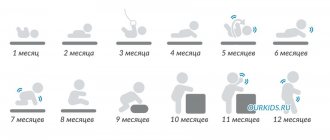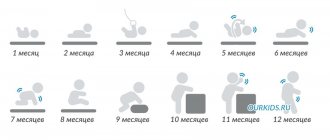Table of approximate daily routine
A child’s routine at eight months consists of certain actions that provide stability and predictability and are repeated day after day. A familiar daily routine helps the baby switch from one task to another with inner comfort, develop successfully and be in a good mood.
Maintaining a daily routine exactly according to the clock is not something all parents can do. The regime is necessary mainly for life planning and the convenience of all family members. You don't have to stick to a minute-by-minute schedule to do this. It is enough just to divide the day by time zones:
- activity time - hours of leisure that the child spends awake, moving and walking;
- feeding time - periods of meals, which can vary at this age from 5 to 7 times a day, including nightly breastfeeding/consumption of formula;
- sleep time is the baby’s daytime and nighttime rest, which in total can be 12–15 hours a day.
To make it easier for parents to organize a daily routine for their baby, below is an approximate table by hour. With its help, you can adjust the daily rhythms of wakefulness, feeding, walking and sleep.
| Time | List of regime processes |
| 6.00 – 8.30 | Waking up, changing diaper, first feeding) |
| 8.30 – 10.00 | Morning dream |
| 10.00 – 10.30 | Baby's second feeding |
| 10.30 – 14.00 | Wakefulness, games, activities with mom, massage and air baths |
| 14.00 – 14.30 | Baby's third feeding |
| 14.30 – 16.00 | Daytime nap (preferably in the fresh air or combined with a walk) |
| 16.00 – 18.00 | Staying awake, playing, being with family and exercising |
| 18.00 – 18.30 | Baby's fourth feeding |
| 18.30 – 20.00 | Walk in the fresh air |
| 20.00 – 22.00 | Swimming before bed, reading, quiet games |
| 22.00 – 22.30 | Fifth feeding of the baby |
| 22.30 – 6.00 | Night sleep time |
Important!
An optimally selected daily routine is an important factor influencing the health of a nine-month-old child.
For an infant, the routine is one of the foundations of the educational process.
Content:
- Basic indicators
- What should a baby be able to do at 8 months? Basic skills for an eight month old baby
- Motor activity, reflexes, motor skills
- Intellectual development
- Features of psychological development, manifestation of emotions and mood
- Changes in the perception of the surrounding world: sense organs
- Speech
- How to organize a safe space for a child?
Differences in daily routines between breastfeeding and bottle-feeding
The daily routine is convenient due to the predictability of feeding hours, thereby allowing you to harmoniously distribute time and energy for other activities. Does it differ in babies with different types of feeding, and what might these differences be? Let's try to figure it out.
Daily routine while breastfeeding
Mothers of children who have free access to the breast may doubt whether they need an hourly daily routine. There is no definite answer here; among doctors you can find both adherents of feeding infants by the hour and supporters of feeding on demand. Mother and baby during breastfeeding can choose their ideal regimen, combining feeding by the hour and on demand, taking a closer look at the baby’s behavior and smoothly adjusting the feeding schedule. It is better to coordinate the intervals between meals with the pediatrician, tracking objective indicators of the baby’s weight.
Daily routine while breastfed
Pediatricians recommend that artificial babies eat on a schedule. But a particular child may have individual needs. An option is possible when partially free feeding is practiced - if it is difficult for the baby to eat the prescribed amount at one time. The main thing is to ensure that the total amount of the mixture eaten per day remains stable.
On a note!
Remember that overeating a baby is just as dangerous as undereating. Sometimes mothers confuse the baby’s hunger with the need to satisfy the sucking reflex. To keep your baby calm and not overeat, you can offer him a pacifier after feeding.
Why is it important to maintain a daily routine?
Maintaining a daily routine is no less important for a child than for parents. The baby learns discipline, to eat, go for a walk and go to bed at the same time, and the mother has more planned hours for household chores. Pros of life according to the regime:
- eliminating uncertainty and everyday fuss;
- reassurance and confidence of the child;
- health promotion - thanks to timely nutrition, walks, swimming, games and recreation;
- preliminary adaptation to the regime of kindergarten and school;
- increasing immunity and strengthening the baby’s nervous system.
Important! The daily routine of a breastfed and bottle-fed 8-month-old child does not differ, with the exception of the point about nutrition. There may be a difference in the complementary feeding introduced, since artificial babies begin to be introduced to solid food earlier.
Competent care for an 8 month old baby
Baby care consists of several procedures. Some manipulations are carried out daily, others – once every 2-3 days or weekly. Each has its own characteristics that you definitely need to know about.
| Morning toilet | Includes washing and changing a diaper. Caring for boys and girls is practically no different. First you need to correctly adjust the temperature and pressure of the water, lather your hand and treat the baby’s skin. Having thoroughly washed off all the dirt and washed all the skin folds, wipe the baby with a dry diaper or towel and apply (if necessary) diaper cream. |
| Washing | At eight months, you can wash your baby with regular running tap water. With your left hand, clasp the baby's head, holding the back of his head and neck. With your right hand, moisten a cotton pad and wipe from your eyes towards your nose. Then change the pad and wipe your cheeks and forehead. Finally, rinse your mouth and chin. Dry your baby's face with a soft towel. |
| Ear cleaning | This area should be inspected and treated 2 times a week. For the procedure, use cotton swabs with a limiter - they will not damage the eardrums. You only need to clean the ear. Wipe the ear with a damp stick or napkin and blot dry. |
| Cleaning gums and first teeth | After feeding, a white coating settles on the gums, which can become a suitable environment for the development of infection. To prevent this, plaque should be regularly removed with a piece of gauze placed on a finger and soaked in boiled water. With the appearance of the first teeth, we change the gauze to a silicone brush in the form of a fingertip and buy toothpaste for the little ones. |
| Taking care of your nails | It is convenient to do a manicure for a baby during sleep, when the child’s hands are relaxed. If the child does not sleep, you will have to involve another adult for the safety of the procedure: one holds, the other carries out the manipulation. Trim your nails with blunt-tipped baby scissors. Don't forget about your toenails - although they grow slower, they also need care. Toenails should be trimmed once every 2-3 weeks. |
Feeding the baby
At eight months, the child receives complementary foods in addition to breast milk or formula. Right now, the mother should gradually accustom the baby to a variety of foods suitable for his age. Let the baby get used to new taste sensations; gradually he will fall in love with the dishes that are prepared for him at home.
By this age, the following products can be added to the menu:
- puree from boiled fish (pollock, cod, hake);
- children's natural yogurt without fillers;
- meat puree with the addition of offal (liver, heart and tongue);
- add parsley, spinach, boiled onions to vegetable purees.
| Sample menu for an 8-month-old baby | ||
| feeding time | breastfed | bottle-fed |
| 6.00 | breast milk (200 ml) | infant formula (200 ml) |
| 10.00 | milk or dairy-free porridge with 1 tsp. butter (180 g), applesauce with cream (30 g), supplementary feeding with breast milk or formula (50 ml) | |
| 14.00 | vegetable puree (170 g) with the addition of meat or fish puree (40 g), ½ boiled egg yolk, supplementary feeding with breast milk or formula (50 ml) | |
| 18.00 | baby cottage cheese (40 g), fruit juice (50 ml), fortified cookies (2 pcs.), breast milk (100 ml) | baby cottage cheese (40 g), fruit juice (50 ml), fortified cookies (2 pcs.), baby formula (100 ml) |
| 22.00 | breast milk (200 ml) | baby formula or kefir (200 ml) |
Important!
Do not force your little one to eat the entire portion against his will, and do not rush him while eating. Feeding should not be done in a hurry or in a nervous environment.
Features of feeding
At eight months, the daily routine is based on the fact that there should be 5 meals. A special feature is the introduction of a new type of complementary feeding. The amount of breast milk consumption during breastfeeding is reduced. If feeding involves an artificial type of nutrition, then you need to include in the menu more food that needs to be chewed.
The nuances of breastfeeding
The amount of breast milk should be 1/3 of the total food. The baby will receive it 2 times (for example, in the morning and in the evening before bedtime). The diet is based on dairy and fermented milk products:
- milk;
- kefir;
- cottage cheese and children's curds.
Also included are cereals, vegetables, fruits and meat (mashed potatoes), bread (bagels, crackers without sugar or additives).
With artificial feeding
There is no need to create a special menu. The products included in the diet are the same as for children on Guards. Fish should be introduced into the diet gradually. It is recommended to make steamed cutlets and give fruit and vegetable juices.
Attention! You can judge whether your routine and diet are correct by looking at your weight gain. Normally, it should be an increase of 0.5 kg per month.
How to deal with constipation?
If your baby has constipation, you should not rush to use laxatives. You can improve your stool with the help of properly adjusted nutrition:
- include fruit juices and purees in your diet. They have a positive effect on the secretory and motor functions of the digestive organs, and also increase appetite;
- fresh kefir acts as a natural laxative. It is enough to give an eight-month-old baby 50-70 ml of baby kefir, gradually increasing the portion to 150 ml;
- pureed prunes will also gently solve the problem of constipation in infants. It can be given separately or mixed with your baby's favorite food. You can also brew 2-3 pieces with boiling water. prunes, leave for 15-20 minutes and give the baby the resulting “compote” after meals. This decoction can be used from 7 months onwards;
- vegetable oil (olive, corn) – added little by little (up to 1 tsp) to food, it has a beneficial effect on the intestinal microflora;
- beets are great for stimulating intestinal function. You can add this healthy vegetable to your child’s soup, or bake it and offer it to your child as a homogenized puree.
Baby's sleep
An eight-month-old baby sleeps at least 8-9 hours at night. The period of daytime sleep can last on average from 3 to 5 hours. The routine plays a big role in the duration of sleep and the ability to fall asleep on time. Kids love predictability, clear sequences, and rituals. In just three days, they get used to how the day goes by the hour, and they look forward to it. Disruption of order affects both mood and well-being. To help your baby sleep better, it is important to organize the right routine.
How to help your baby fall asleep?
It's hard to go to sleep if you're not tired yet. The child’s brain tends to sleep when it is necessary to process information received in leisure time and give the body rest. This means that the guarantee of sound infant sleep is fatigue and impressions:
- listen to songs with your baby, turn on the music and dance happily to it;
- do exercises with the baby, jump on a fitball, massage the body, learn to swim and talk;
- While walking, show your child everything around and comment on what is happening.
- Before putting your child indoors, do not forget to ventilate the room in advance.
One of the above actions or several in combination will definitely work.
Sleep problems - what to do?
If the baby is capricious in the evenings and does not want to fall asleep on time, you can try to solve the problem with a soothing bath. An hour before bedtime, prepare a warm bath for your baby with the addition of a herbal decoction. Motherwort leaves, oregano herb, and valerian root are perfect for the decoction. The herb should be brewed at the rate of 3 tbsp. for every 10 liters of water. After swimming in water with a healing aroma, the baby will relax, eat with pleasure and fall asleep sweetly.
As a child gets older, his sleep becomes more and more similar to that of an adult. Phases of sleep appear: deep and fast. The amount of daytime sleep gradually decreases, and the quality of night sleep becomes much better than before. This happens because the child has already experienced several crises, sleep regression at 4 months, and now the time has come for a calm and predictable rhythm.
In order for your baby to sleep soundly day and night, it is important to properly organize the rhythm of the day.
Skills at 8 months
Let's first remember the whole path that the baby has already gone through and what he has learned.
By this age, the child already knows how to: hold his head up independently, sit (or is about to start sitting up), crawl (in one direction), make various sounds, begins to understand speech, grimaces, and can grab the toy he needs. The baby’s gaze is already completely conscious; he can make it clear through his behavior that he doesn’t like something. The child is already actively eating complementary foods, and some children are beginning to gradually move to the common table.
If your baby has more or less of the skills described above, this does not mean that there is something wrong with him. Remember that here, as with the norms, each little one has his own.
Sleep and wakefulness norms for 8 months
At this age, during the daytime, some children sleep 2 naps, and some may still sleep 3 naps. The duration of sleep during the day for a baby at this age is on average 2-3 hours. This time can be evenly distributed between dreams, or some sleep can be longer and the rest shorter. If the child has already slept for two sleeps, then the total duration can be divided in half.
With regard to wakefulness, everything is also individual, but there are average values that you can focus on. During one wakefulness, babies can walk for 3-4 hours. This means that 3:15, 3:20 or 3:30 can also be a variant of the norm.
Such a wide range of waking hours is made so that you can test different options and find the optimal number for your baby.
Night sleep can last from 09:30-12 hours. And, if your baby gets most of the daily sleep during the night and problems with DS arise, this means that you need to reconsider the duration of night sleep.
A breastfed baby may wake up to eat on average 1-2 times, in rare cases 3 times. Babies who eat formula usually eat once or don’t eat at all.
How to organize sleep and wakefulness for a child at 8 months? The most important thing you can do for your baby is to create a predictable rhythm for him. The predictable rhythm includes a fixed time of getting up in the morning, alternating sleep and wakefulness. Then the mother knows exactly the periods of time that the baby walks and clearly controls the duration of daytime sleep.
Approximate daily rhythm for a baby:
- 06:00 Wake up;
- 06:30-09:00 Hygiene procedures, food, walk, games with mom;
- 09:00-10:00 Sleep (can be organized outside in a stroller);
- 10:00-13:30 Changing diapers, feeding (solid feeding), practicing physical skills, joint calm games with mom, massage, relaxation;
- 13:30-14:30 Sleep;
- 14:30-17:30 Walk. Food, bathing, games;
- 17:30-18:00 Sleep;
- 18:00-21:00 Last wakefulness, which includes: massage, active and calm games with parents, short walk, procedures before bedtime;
- 21:00 Leaving for the night.
Remember that it is also important to properly organize stress and relaxation during every waking moment so that the baby does not over-walk or become overexcited. Or vice versa, so that there is no situation when he becomes bored, which entails excessive moodiness.
It is quite difficult for a child at this age to control anything on his own. For example: entertain yourself for a long time or sit and play calm games. When the baby is awake under the control of the mother, then, as a rule, such wakefulness is quite positive. Since the baby, in the process of interaction, receives involved attention from the mother, which also represents an intellectual and emotional load. This load, in turn, creates good sleep pressure.
Why can a baby sleep poorly at 8 months?
The reasons for poor quality sleep in children can be completely different. In order to understand what exactly prevents the baby from sleeping deeper and waking up less, you need to start checking point by point. Only testing will lead you to the correct answer.
Causes of poor sleep:
- External conditions are not suitable. Download the “COMFORT AND SLEEP” CHECKLIST and check point by point;
- The organized rhythm of the day does not suit the baby;
- Physical discomfort (teeth, diseases);
- Lots of daytime sleep. Either it is incorrectly distributed;
- Insufficient load;
- Little relaxation;
- Growth spurt;
- Association for falling asleep;
- The child lacks mother's attention;
- Mom is in a total loss and the baby feels it;
- Over/under.
Favorable conditions for sleep
The reasons for poor sleep are described above. There are enough of them to find among them something that might resonate with you. To help your baby sleep well, start eliminating one factor after another:
- Optimize external conditions; there should be no items marked “no” on the checklist. Only if they are not suitable for your age.
- Lock in your morning and start working with rhythm.
- Make all internal rituals predictable. Food, walks, massage, games and swimming.
- Start monitoring the length of time you wake up and sleep during the day.
- Work with your condition. Ask loved ones to help you, or find ways to help yourself. Lie down and rest with your baby and allow yourself not to do anything that is not urgent or unimportant.
- If your baby has a leap, be patient and help him through it with your love and support. Remember that if the baby has a rhythm to the day, then any jumps will be easier.
If you have tried everything, but the problem remains, then there are two options: either the problem lies in the rhythm and you need to look into it in more detail with the help of a consultant, or you need to work with the association. You can work on both in any format in the course “BABY’S SLEEP, MOTHER IN RESOURCE (+SZ)”. The work is both individual and independent, but with the support of a consultant in the general chat. Write and we will select the tariff that suits you.
Remember that absolutely all sleep problems can be solved if you deal with them. Start with something simple, namely the proper organization of your day. And you will see how not only your daytime sleep, but also your nighttime sleep will change.
Author: Tatyana Kremneva.
Physical and psychological development at 8 months
The 8th month of a child’s life is often rich in impressions and achievements. The baby can stand on its own legs for the first time, without outside help. This month can also please parents with the ability to sit down, sit confidently, and lie down from a sitting position.
- Now the baby will increasingly play while sitting. And children like communication with adults in this position much more. Moreover, you can grab two toys at once - one in each handle, and throw them at the same time.
- On a walk or in a store, a child looks at everything around him with pleasure, is emotionally surprised and reaches out to what attracts him. And almost everything can attract attention - toys, cutlery, food, and especially mom’s mobile phone. Socialization is going well!
- The “young tracker” masters crawling on all fours, and by the end of the month he will be able to move confidently and quickly in this way. This will allow the baby to explore the whole house, so the mother will have more trouble - now she should be especially careful about cleanliness and safety.
- At the age of eight months, the baby experiences a strong attachment to the person who spends the most time with him. Of course, in most cases it is the mother. He worries if he loses her or another adult close to him from sight, even for a short time.
- The baby begins to actively crawl, and can move both towards the object of affection (mother) and away from him. In the second case, the child uses the mother as a support point. From time to time, the little one will check if he is safe while he explores the world around him.
- Right now, the fear of strangers is intensifying, at the sight of whom the child may show a negative reaction. If there are a lot of strangers in the house, or you are visiting, the baby may behave restlessly or cry a lot, and be afraid to get out of your arms.
Physical development
At 8 months, the baby’s activity reaches its peak - he does not give his parents a second of quiet time during the waking period, and daytime sleep is reduced by up to two times. The baby explores the world with interest, crawls, explores all the objects it can reach, and often tastes them.
However, it should be remembered that there is a wide range of skills, physical and psychological characteristics that accompany the development of a child at 8 months. A girl and a boy also show them differently. Weight gain expectedly slows as physical activity increases. On average, babies gain 500-600 grams of weight and grow a couple of centimeters.
Of course, a lot depends on the physiological characteristics of the parents. With a tall mother and father, the baby can grow by 5 centimeters, and if the mother has fatty milk, he can gain 1 kg of weight. Therefore, tables of height and weight always indicate the lower and upper limits of the norm, which you can use as a guide. On average, according to Russian pediatricians, the normal weight for girls at this age is 7-9 kg with a height of 66-72 cm, and for boys - 7-10 kg with a height of 66-73 cm.
| Indicators | Bottom line | Upper limit |
| Boys' weight, kg | 7,5 | 10,0 |
| Girls' weight, kg | 7,2 | 9,3 |
| Boys' height, cm | 66,8 | 73,1 |
| Girls' height, cm | 66,0 | 72,5 |
The World Health Organization operates with slightly different standards for height and weight:
| Indicators | Bottom line | Upper limit |
| Boys' weight, kg | 6,9 | 10,7 |
| Girls' weight, kg | 6,3 | 10,2 |
| Boys' height, cm | 66,2 | 75,0 |
| Girls' height, cm | 64,0 | 73,5 |
| Boys' head circumference, cm | 42,0 | 47,0 |
| Head circumference of girls, cm | 40,7 | 46,0 |
There is no need to be afraid that one of them lags behind their peers if teeth have not yet erupted or they cannot crawl quickly or sit for a long time without support. However, pediatricians highlight the exact signs and basics of what a child should do at 8 months, which should be encouraged and developed in a playful way, helping them to form and consolidate. A physically developed child can usually:
- Sit down from a lying position, sit without support or with the help of a pillow, stand up holding a solid base or the hands of an adult, and maintain a standing position.
- It can roll over in any direction or spin in one direction, so it is dangerous to leave it on the bed or changing table - the baby can fall in one second, even if it seems that he is far from the edge.
- Hold the bottle with both hands and drink from it, controlling the process, and also pick it up if it falls.
- Study the movement of your own fingers, choose a toy from a variety, throw it, expecting mom or dad to pick it up.
- Remove pyramid rings, flip through thick pages of children's books, press buttons on musical toys.
- Crawl on all fours or on your belly, or at least try to do this, especially when you see a new interesting toy nearby.
- Place small cups in large ones, try to open cabinet doors, untie the knots of ribbons that can be used to secure them.
Many parents panic when they see their sedentary son or daughter's 8-month-old peers actively crawling and rolling over. There is no need to worry ahead of time; it happens that the brain is busy mastering psychological skills, which will later be expressed in actions. A child of 8 months should be able to first subconsciously draw up a plan of action, and then implement it physically. But in any case, a special massage complex from a specialist or on your own, according to educational videos and books, will only be beneficial - it will relieve tone or strengthen the necessary muscles.
Learning while playing: activities with a baby at 8 months
The baby was born 8 months ago, and is not yet aware of his “I”. He does not know about the different parts of the body and their names and has not yet even thought about whether he is a boy or a girl. The task of parents is to introduce the baby to his own body, to help him realize himself and his uniqueness. And this is best done with the help of simple and interesting games for the child.
| Who am I? | The first games are aimed at distinguishing between close people and yourself. First, you can play the game: “Where is mom?” Let one of the adults ask the baby where his mother is. If the child does not understand what to do, the adult points his finger at the mother and says: “Here is mother!” We teach the child to show himself in the same way. We ask: “Where is Misha?”, take the little one’s hand in our hand and help her point to us: “Here is Misha!” Don't be upset if your little one doesn't succeed right away. Just devote time to this game every day and everything will work out. |
| What am I? | Introduce your child to the names of body parts from a very early age. You just need to touch his legs, arms, nose, and say what it is. You can also teach body parts while doing household chores. For example, we dress the child and say: “Now let’s put on Katyusha’s socks. Here are the toes, here is the heel. Now let's put on our pants. Here’s the leg, here’s the knee.” |
- When washing or bathing a baby, hum a poem to him and at the same time touch the named part of the body. You can touch your nose or forehead with your finger, or take the child’s hand and bring it to different places on the face, thereby stimulating the memorization of external organs.
“Snout - spout! Where are you, little nose? Mouth - mouth! Where are you, little mouth? Cheek - cheek! Where are you, cheek? There will be a clean daughter! (or – we washed our son!)”
- It is also helpful to teach body parts using toys. Take any toy, for example, a bear cub, sit the child next to him and ask him: “Where are the bear’s ears?” Take the baby's hand, touch his ear, and say: “Here is the ear!” After several repetitions, the baby will show his ears himself.
- Once your baby has mastered the body parts on one toy, replace it with another. Gradually, the little one will learn that everyone is structured in approximately the same way, and will begin to accurately identify the right places even in unfamiliar toys.
- In the same way, you can play with pictures in children's books: show where the drawn characters have eyes, paws, and tails. Pictures of animals should be large and understandable to the child.
8 month crisis and sleep disturbance
Due to rapid development and increased physical, emotional and social stress, many mothers face an 8-month crisis. Signs:
- short naps during the day – 20-40 minutes;
- frequent waking up at night, the baby may be capricious and cry 40 minutes or an hour after falling asleep;
- difficulties with laying down - the child cries, arches, screams;
- inability to adhere to the daily routine;
- demandingness, moodiness while awake;
- change in appetite - little ones can eat a lot, and children with a good appetite begin to refuse food.
If symptoms persist for more than 14 days, they speak of sleep regression in an 8-month-old child.
Is it possible to put a child in a walker?
At eight months, the baby has already learned to take a vertical position with support on his legs, and many parents wonder whether it is possible to put the baby in a walker. Indeed, 8-9 months, suitable for short-term use of walkers. Meanwhile, you shouldn’t get carried away with this device. It is not necessary to abandon it completely, but there are a couple of points that parents should consider when using this children's device.
- The time spent in the walker should be limited. In ordinary life, a child constantly changes body position: sits down, crawls, lies down, etc. In a walker, the baby is forced to be in an unnatural vertical position for his age, which does not benefit either his spine or the musculoskeletal system as a whole.
- It is important to understand that walkers can only be used as a “lifesaver” for mom, for example, when she needs to go to the bathroom for a couple of minutes. At the same time, the space in which the baby will move must be completely safe: all objects that are within the distance of the child’s hand must not cause him harm in any case. Chests of drawers, electrical appliances, furniture with sharp corners, etc. are especially dangerous.
Baby care and hygiene
At 8 months old, you still need to bathe your child every day, following the rules of hygiene and treatment after the procedure. For example, in the morning the baby’s hands and face are wiped with boiled water, after which the nostrils and ears are cleaned, nails are trimmed, etc. Care and bathing products should be selected that do not cause allergies, without strong odors.
Bathing a child
Almost all children love to swim, and taking a warm bath is considered a must in their daily routine. A child of 8 months can be offered silicone ducks, boats and rubber toys. The bathing procedure should take 20-25 minutes, after which it will be easier for the baby to fall asleep. The water temperature is ideally 30-37°C if the baby is comfortable in it. If after bathing the baby becomes agitated and has difficulty falling asleep, it is better to postpone the procedure to daytime.
Massage and gymnastics
These procedures are designed to strengthen the baby’s muscle tissue and its physical development. Parents can perform gymnastic exercises themselves if the child is healthy and feeling well. You can start the massage 40-50 minutes after eating by lightly stroking the skin (using baby oil is acceptable). The legs and arms are stroked from bottom to top, the back along the spine, but not along the pillar itself, and the tummy clockwise. Then the skin is gently kneaded, rubbed, arms and legs are shaken. Gymnastics and sets of special exercises will be recommended by a pediatrician, depending on the health status of the baby and the degree of its physical development.











